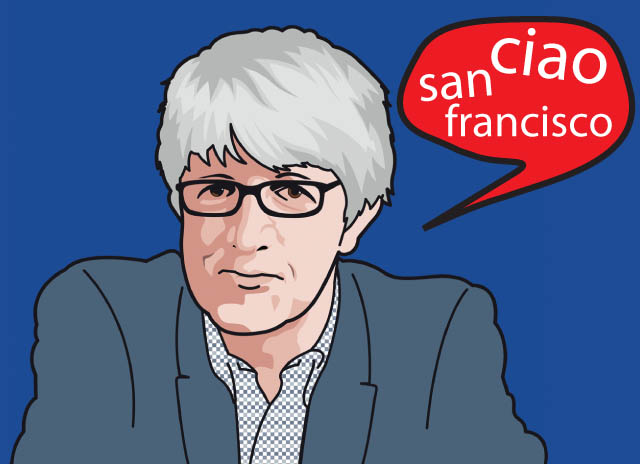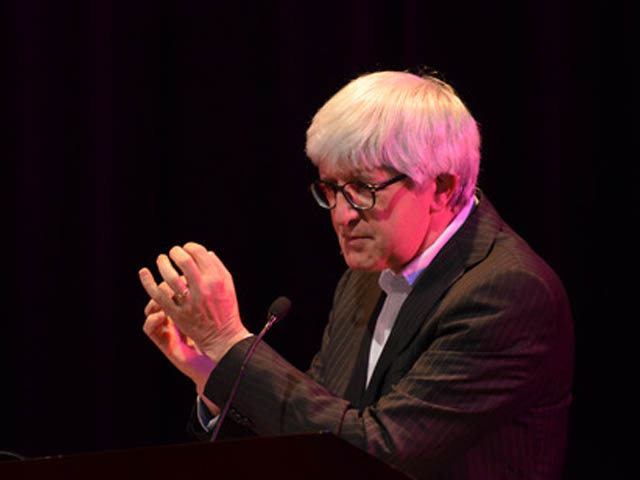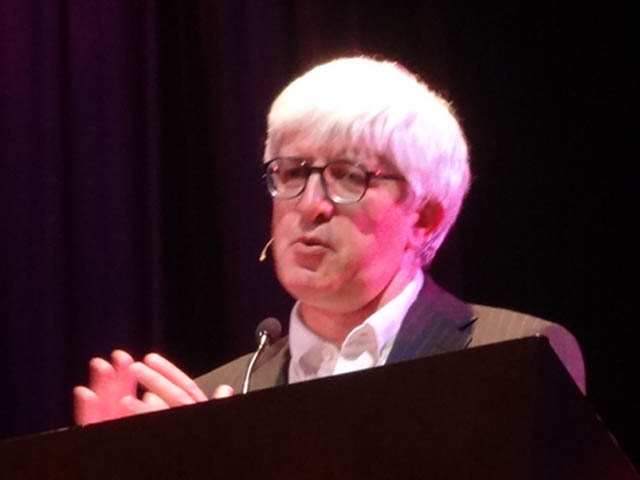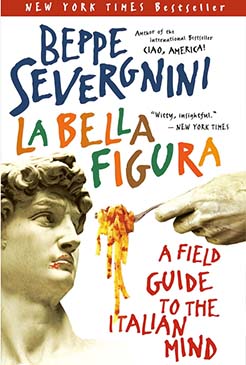
Beppe Severgnini a San Francisco: Un ponte tra culture
Beppe Severgnini in San Francisco: A Cultural Bridge
Beppe Severgnini: Un’analisi brillante tra due mondi
Beppe Severgnini: A Brilliant Analysis Between Two Worlds
Mercoledì scorso è stato un vero piacere ascoltare Beppe Severgnini parlare a San Francisco, in un evento co-organizzato da BAIA, il Consolato e l’Istituto Italiano di Cultura. Il tema della discussione era: “Italiani e Americani: Come ci vediamo a vicenda”.
Last Wednesday, it was a real pleasure to hear Beppe Severgnini speak in San Francisco at an event co-hosted by BAIA, the Consulate, and the Italian Cultural Institute. The topic was: “Italians and Americans: How We See Each Other.”

Chi è Beppe Severgnini?
Who is Beppe Severgnini?
Se non avete mai sentito parlare di Beppe Severgnini, vi consiglio vivamente di leggere i suoi lavori. È un giornalista italiano del Corriere della Sera dal 1995 e, di recente, editorialista del New York Times. È anche autore di libri esilaranti come La Bella Figura e Ciao America!, che offrono profonde intuizioni sulle psicologie italiana e americana.
If you haven’t heard of Beppe Severgnini, I highly recommend reading his work. He’s been an Italian journalist at Corriere della Sera since 1995 and recently an op-ed columnist for The New York Times. He’s also the author of hilarious books like La Bella Figura and Ciao America!, offering sharp insights into Italian and American psyches.

I Quattro Grandi C: Cambiamento, Controllo, Coreografia, Competizione
The Four Big Cs: Change, Control, Choreography, Competition
Cambiamento / Change
Gli americani trovano il cambiamento affascinante, qualcosa da abbracciare con entusiasmo. Gli italiani, invece, pur sembrare rivoluzionari, sono conservatori nel profondo, trovando il cambiamento spaventoso.
Americans find change fascinating, something to embrace wholeheartedly. Italians, by contrast, though they appear revolutionary, are deeply conservative, finding change intimidating.
Controllo / Control
Gli americani si sentono rassicurati dal controllo, attraverso la logica e l’organizzazione. Gli italiani trovano il controllo noioso, preferendo vivere di spontaneità e intuizione.
Americans find comfort in control, through logic and organization. Italians, however, find control boring, preferring to live by spontaneity and intuition.
Coreografia / Choreography
Gli americani amano le grandi manifestazioni pubbliche come lauree e matrimoni. Gli italiani si concentrano sulla coreografia della vita privata, partendo dalla tavola da pranzo.
Americans love grand public displays like graduations and weddings. Italians focus their choreography on private life, starting at the dinner table.
Competizione / Competition
Gli americani hanno trasformato la competizione in uno stile di vita. Gli italiani, invece, reagiscono con diffidenza e irritazione, temendo più la sconfitta che il confronto.
Americans have turned competition into a lifestyle. Italians, however, react with mistrust and irritation, fearing failure more than embracing challenges.

Oltre gli stereotipi
Beyond Stereotypes
Se superiamo gli stereotipi evidenti, ci accorgiamo che gli italiani sono maestri del bel gesto: l’arte di fare atti gentili, spesso per se stessi come spettatori. La sfida italiana, dice Severgnini, è trasformare i bei gesti in buoni comportamenti.
If we move beyond obvious stereotypes, we find Italians are masters of the bel gesto: the art of kind acts, often performed as their own audience. The Italian challenge, Severgnini says, is to turn kind gestures into consistent good behavior.
Bepp Severgnini
Un ricevimento indimenticabile
An Unforgettable Reception
Dopo il discorso, c’è stato un ricevimento con prosecco, dove ho ritrovato vecchi amici e ne ho conosciuti di nuovi. Sentire Severgnini parlare della psiche italiana mi ha illuminato e mi ha aiutato a capire perché amo una cultura così diversa dalla mia.
After the talk, there was a prosecco-filled reception where I reconnected with old friends and made new ones. Hearing Severgnini analyze the Italian psyche enlightened me and helped me understand why I love a culture so different from my own.
Link utili e ringraziamenti
Useful Links and Acknowledgments
Potete leggere i commenti di Severgnini sul discorso qui: Italians, Corriere della Sera
You can read Severgnini’s thoughts on the talk here: Italians, Corriere della Sera
Grazie alla mia amica Maria Luisa Manca per le foto!
Thanks to my friend Maria Luisa Manca for the photos!
Find Beppe Severgnini’s Books on Amazon
Find more Italian books and learning materials
on the Matta Amazon Page
Leggere libri in italiano ti immerge in un vocabolario autentico, nella grammatica e nelle espressioni culturali, aiutandoti a capire come la lingua viene usata naturalmente. Migliora la tua comprensione e ti dà sicurezza esponendoti a strutture frasali e frasi idiomatiche nel loro contesto.
Reading books in Italian immerses you in authentic vocabulary, grammar, and cultural expressions, helping you understand how the language is naturally used. It enhances your comprehension and builds confidence by exposing you to sentence structures and idiomatic phrases in context.














So che lui ti piace parecchio,quindi mi guardo dall’esprimere la mia opinione su Severgnini in pieno.Dico solo che anch’io avrei partecipato volentieri alla serata,però solo per il prosecco.Spero che fosse gratis.
P.S. Auguri tardivi per la festa della mamma a te,Melissa! Sei una mamma straordinaria 🙂 🙂 🙂
Almeno tre dei miei amici italiani sono d’accordo con Leo! Mi è piaciuto il primo libro di Severgnini che ho letto, ma ho trovato il secondo troppo simile al primo. Ciononostante, se fosse venuto nella mia città, sarei andata a sentirlo!
Adoro il nuovo design del tuo sito, Melissa!! Brava!! 🙂
Grazie Edina! Ho deciso era ora per un piccolo cambiamento. Spero che sia più facile trovare altri post da leggere!
I read La Bella Figura – in fact I’ve kept it to reread. I felt that at times he was ridiculing Italians. I don’t like generalizations. I believe Italians are not so naive as to think all Americans are a certain way or I don’t believe we are so uninformed as to believe that all Italians are as Bebe Severgnini describes. I think he may be a bit jaded.
I struggle too with extreme stereotyping and making broad sweeping national generalizations for both Americans and Italians. In my self I see personal characteristics that could go either way in both sets of criteria that Severgnini outlines for Americans & Italians. It isn’t fair to stick labels on people and then say this is exactly how they are and “ah ha” now we understand why. But, at the same time our two countries are different in the ways we approach things and there are some great differences between our two lifestyles, as there are some great differences also between Italo-American culture and Italian culture.
So it is an interesting thing to contemplate and ruminate over as to what those differences are and how they translate to creating different cultures and outlooks for groups of people and nations. As a person who likes to study human nature it is interesting to me to read Severgnini and see if it holds true to my litmus test and my experiences of traveling in Italy and the friends and people that I work with and know in Italy. Some things don’t ring true in my opinion. Some things do, at least a little.